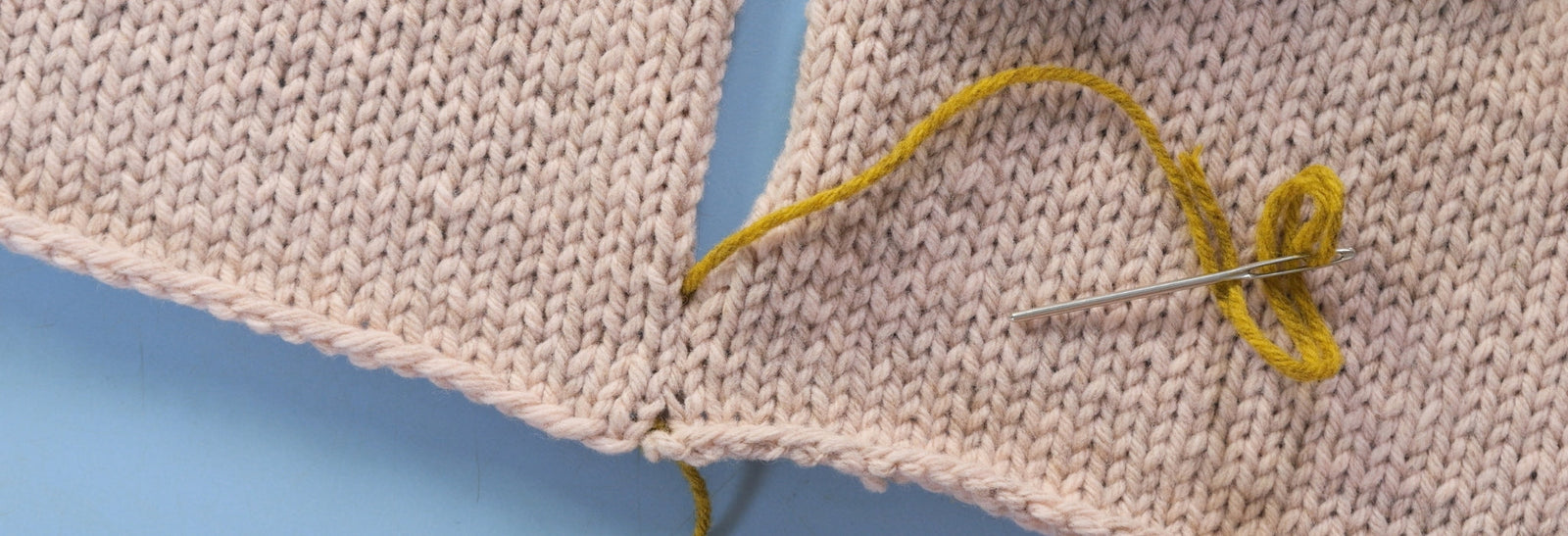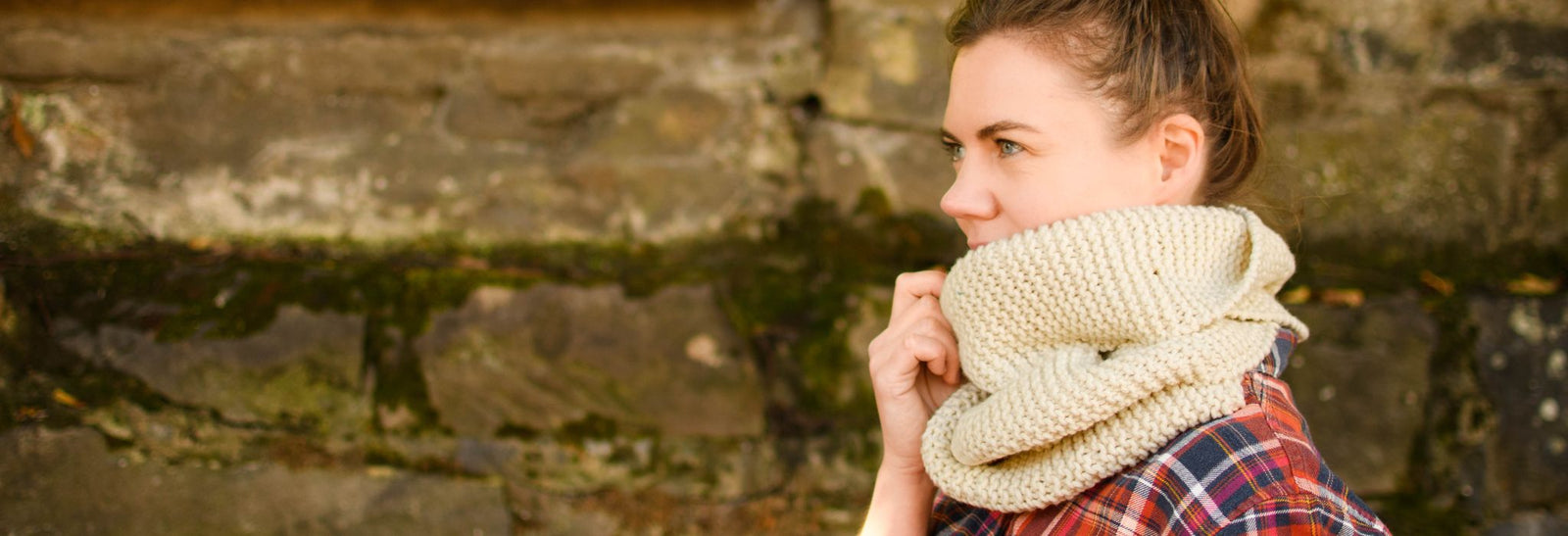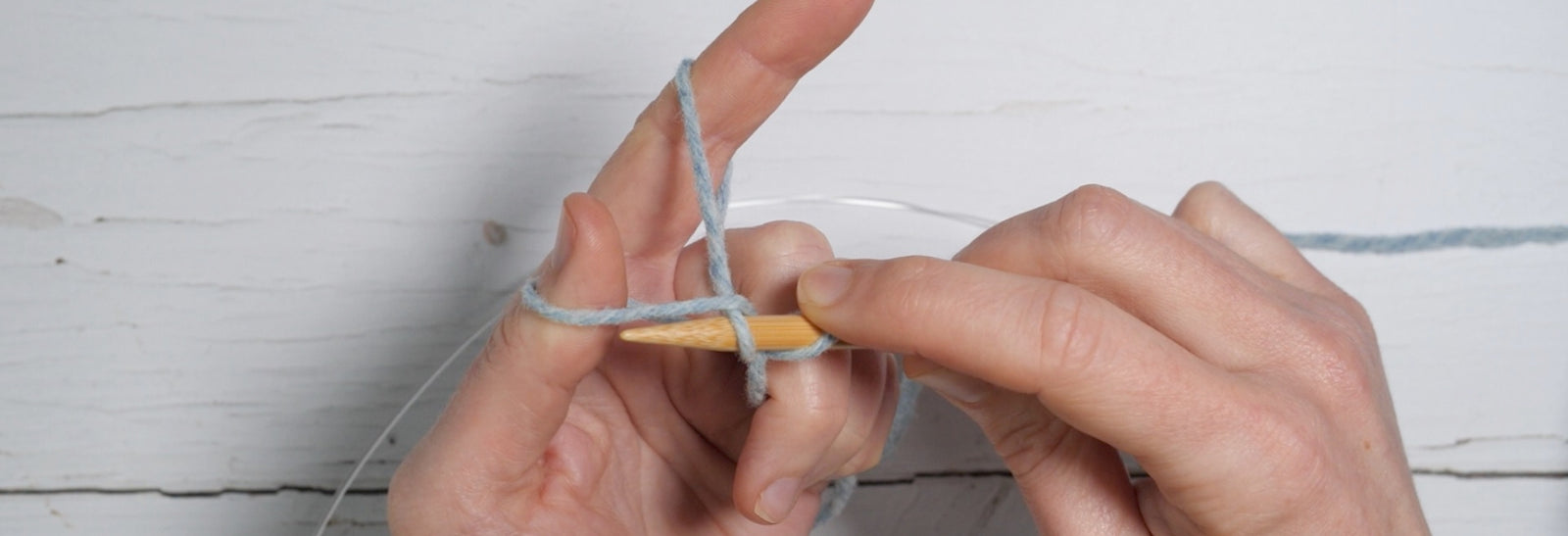Your Cart is Empty

How to choose what size to knit from a sweater pattern
March 01, 2019
Confused by which size of a sweater pattern to make? To get the best fit you'll want to know what size you are, and how to read the sizing information provided in your pattern.
What size are you?
Just like in ready to wear clothing, there isn't really a consistent sizing system that's used universally in knitting patterns, although if you often knit patterns by one designer or publisher you might be able to work out your size for that brand. The only way to know for sure what size you are is to take your measurements. Knitting patterns are usually sized by the finished chest or bust measurement, but sometimes the intended body measurement is given instead. In that case look to the schematic for the finished garment measurements. A schematic is a line drawing of what your finished sweater, or the individual pieces of your finished sweater, will look like, with measurements for all the sizes given on, or alongside, the illustration.
What's the difference between finished measurements and body measurements?
It's important to make sure you understand which measurements provided in your pattern are the finished measurements of the sweater, and which are of your body. They shouldn't all be the same, and the finished measurements of your sweaters will vary depending on the style and fit.
Ease
The difference between your body measurements and the finished measurements of the sweater is called ease. This is referred to as negative and positive ease. Negative means that the sweater is smaller, while positive means that it's larger than the body. Some patterns will tell you what size the model is wearing and their chest measurement while others will give a suggested amount of ease to help you choose your size.

Ease is partially a matter of personal preference. There are usually a couple of sizes in a pattern that you can choose between, depending on how fitted you like you're sweaters, but you don't want to stray too far from the designers intentions or the proportions will be very off. If you want an oversized style look for a pattern that's intended to be worn with lots of positive ease, rather than making a much larger size of a fitted design. Scroll down to see the same designs on different people.
Measuring existing sweaters
It can be helpful to measure garments that you like the fit of and compare those to the finished measurements provided in the pattern. Consider whether the garment you're measuring will have a similar fabric, in terms of thickness, drape and stretch, as your project.
How to take your measurements
Before taking body measurements, if you're someone who wears structured bras, it might be worth getting a fitting. Wearing the right bra size can make a huge difference to the measurements you end up with, and the fit of your sweaters. Check out this older post on how to tell if you're wearing the right size and what a difference it can make.
Measure over close fitting garments, including, if applicable, the kind of bra or binder you'll wear with your sweater. Keep the tape measure level all the way around your body, snug but not too tight.
The measurements you'll take will depend on your body and the kinds of sweaters you want to make. Skip the ones that don't apply to you.
Before beginning use string and stickers to mark a few key points:
- The natural waist. If you aren’t certain where your waist is bend to the side or feel for the curve at your lower back — this bend is the natural waist. Tie a piece of string around. Tie a second piece around the underbust, at the bottom of your bra’s underwire.
- Run a finger from the side of the neck to the shoulder until you find the end of the bone and mark with a sticker.
- On the side of your hip mark where you would want a regular length sweater to end.
- Close to your armpit on your body mark where you would want the bottom of a close fitting armhole to be. Make this easier to refer to by tying string around your arm at this level.
- If you think you might need some extra shaping for the bust mark your nipples with stickers. Yes really!

Download a printable worksheet you can fill out with your measurements.
Comparing body measurements to the schematic
Compare your body measurements plus the amount of ease you'd like to the garment measurements given in the pattern. Remember to refer to the schematic for the most extensive list of garment measurements. Here's the schematic from Ravelston.Because there are a lot of sizes the measurements are given in a table below the illustration.

What size should you make if you have a larger bust?
Most knitting patterns aimed at women are sized by the bust measurement. This doesn't make much sense, and I go back and forth on whether to continue sizing my patterns like this. The full bust measurement can be dramatically different between two people who are otherwise close to the same size.
Unisex patterns and patterns aimed at men tend to be sized by the chest without being shaped to curves.
If you have a larger bust you'll find that choosing a size that matches your high bust measurement to the bust / chest size given is likely to be the best starting point.

Do you need to make changes to the fit of your pattern?
You probably won't find that all of your measurements fit neatly into one size of the pattern. Maybe you need longer sleeves, narrower shoulders, or more shaping at the bust. Choose a size that gives you the closest starting point.
If you're making a closer fitting garment you might need to make changes to the shaping or combine stitch counts from different sizes to get the best fit for your body. Look out for more posts on how to make specific changes and let us know if there's something in particular that you've been struggling with. You might also be interested in my book Little Red in the City which includes an extensive section on making changes to patterns.
A visual comparison
We thought it might be helpful to see the same designs on different people, and the same person wearing different sizes.
Wardie

You can also see me wearing this sample, styled a bit differently in the original pattern photos.It's the size 37 1/4" - that's around 2" of positive ease.

This is me wearing the size 46", that's closer to 10" of positive ease. Note that the sleeves are a little long but not ridiculously. Bex made this Wardie for herself, and shortened the sleeves to fit her shorter arms. If you want to make Wardie with a lot more positive ease to match this slouchier fit, which I love, you'll probably want to shorten the sleeves. The oversized fit pushes the top of the sleeve further down your arm so you need to compensate for that. Love the colour? It's Finull PT2 in 438.
 We recently met up with our friend Aja Barber and she kindly posed for a few pictures. If you're interested in ethical fashion, conversations about race and intersectional feminism, or looking for styling help check out Aja's Patreon and instagram. Here she's modelling the same blue Wardie with less ease.
We recently met up with our friend Aja Barber and she kindly posed for a few pictures. If you're interested in ethical fashion, conversations about race and intersectional feminism, or looking for styling help check out Aja's Patreon and instagram. Here she's modelling the same blue Wardie with less ease.
And here's the same one on Bex. You can tell they're a similar size but that Aja is a little taller with broader shoulders. She also made her top from the Concord pattern by Cashmerette, which is a great option if you're looking for a sewing pattern for a fitted tee sized for plus sizes / larger cup sizes.

Ravelston
For the pattern photos of my latest pattern, Ravelston, I modelled the grey v-neck. You can see that the yellow one has a looser fit with more positive ease on Noor than it does on me (this one has more or less zero ease at the full bust on me).


Also in Journal

Learn to Knit: Mattress Stitch
March 29, 2023
By following our step-by-step mattress stitch knitting tutorial, you'll learn how to make your seams look beautiful and how best to prepare your knitting so that when you seam it with mattress stitch, it goes smoothly on the first try.
Read More
How to Knit a Scarf: A Beginners Guide to Scarf Knitting
March 23, 2023
Want a quick and easy beginners tutorial on how to knit a scarf? This garter stitch scarf is easy to knit and requires just 3 skills; casting on, the knit stitch and casting off.
Read More
Learn to knit: the long tail cast-on
February 03, 2022
The long tail cast on is a great multi-purpose knitting cast on and the perfect place for beginner knitters to start. Learn how to work the long tail cast on and how to estimate the length of yarn needed with our clear step by step tutorial and video.
Read More Recent Articles
- Learn to Knit: Mattress Stitch March 29, 2023
- How to Knit a Scarf: A Beginners Guide to Scarf Knitting March 23, 2023
- Learn to knit: the long tail cast-on February 03, 2022
- How to Kitchener Stitch December 09, 2021
- Crochet Provisional Cast-on December 02, 2021
- Learn to knit: How to knit in the round with double pointed needles November 25, 2021
- Learn to knit: How to knit in the round using the magic loop technique November 25, 2021
- Learn to knit: How to knit in the round November 25, 2021
- Knitted Gift Ideas for you and your loved ones November 18, 2021
- Celebrating our Porty Hat Preview Knitters October 28, 2021
Free resources
-
KALS, step-by-step pattern guides and free patterns
Learn brioche with the free Daniel's Hat pattern
Tombreck - a free chevron beanie pattern
Working the brioche neck detail on the Polwarth sweater
Basics
Casting on
Decorative Channel Island Cast-on
Binding off
3 Easy Stretchy Bind-offs (p2tog bind-off; k2togtbl, k1 bind-off; Jeny's surprisingly stretchy bind-off)
Tubular Bind-off for brioche stitch
Increasing
Paired increase methods compared
Decreasing
Brioche stitch double decreases
Knitting in the round
How to Knit in the round using Magic Loop
How to Knit in the round using DPNs
Short rows
Swatching and gauge
Tips and tricks
Avoiding ears when binding off
Tighter purl stitches for neater cables and ribbing
Cabling without a cable needle
Reading knitting patterns
Understanding "continue in pattern"
Finishing
Garment knitting
Joining the body and sleeves on a seamless bottom up sweater
Sizing
Inclusive garment knitting
How to pick a garment without a model for you (specifically addresses finding garment patterns when your gender identity isn't represented and the styles you want to knit might not be sized to fit your body)
How does ease affect inclusive size ranges?
Specific stitch patterns
Lace
Identifying and fixing mistakes in lace knitting
Colourwork
Getting started with stranded colourwork
Understanding colour dominance
Working stranded colourwork over small circumferences
Decreases in stranded colourwork
Holding the yarn for stranded colourwork
Ladderback Jacquard (a neat way to deal with long floats)
Cables
Cabling without a cable needle
Cabling without a cable needle on the wrong side
How to knit cabled decreases
Closed ring cable increases and decreasesBrioche
How to work brioche stitch in the round
Other crafts
Cross stitch
How to begin your first large cross stitch project
How to finish a cross stitch project with an embroidery hoop frame
Mending

Sign up today
Find out the latest news from the studio such as sales, pattern releases, and new workshops or KALs our learning community, The Knitwork. We also share helpful tips and exclusive subscriber discounts...

